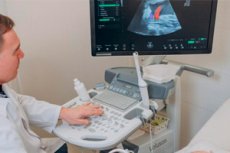
All iLive content is medically reviewed or fact checked to ensure as much factual accuracy as possible.
We have strict sourcing guidelines and only link to reputable media sites, academic research institutions and, whenever possible, medically peer reviewed studies. Note that the numbers in parentheses ([1], [2], etc.) are clickable links to these studies.
If you feel that any of our content is inaccurate, out-of-date, or otherwise questionable, please select it and press Ctrl + Enter.
Transabdominal ultrasound of pelvic organs
Medical expert of the article
Last reviewed: 06.07.2025

Ultrasound is a diagnostic method that uses reflected ultrasound of certain frequencies to visualize internal organs located, among other things, in the pelvic cavity: the bladder and rectum, the uterus with its appendages and ovaries; in men, the prostate gland. What is transabdominal ultrasound of the pelvic organs? This is a routine ultrasound examination performed through or across (in Latin - trans) the abdomen (in Latin - abdominis), that is, through its anterior wall. [ 1 ]
Ultrasound is a diagnostic method that allows, using reflected ultrasound of certain frequencies, to visualize internal organs located, among other things, in the pelvic cavity: the bladder and rectum, the uterus with its appendages and ovaries; in men, the prostate gland. What is transabdominal ultrasound of the pelvic organs? This is a regular ultrasound examination performed through or across (in Latin - trans) the abdomen (in Latin - abdominis), that is, through its anterior wall.
The main indications for this examination, what contraindications exist, how to prepare for the procedure, as well as the technique of implementation are covered in detail in the publications:
- Ultrasound of the pelvic organs and uterus
- Indications for pelvic ultrasound
- Preparation for pelvic ultrasound
Read about when and how transabdominal ultrasound of the bladder is performed:
- Ultrasound in urology
- Ultrasound of the bladder
- Indications for ultrasound of the bladder
- Preparation for ultrasound of the bladder
In the same cases, transabdominal ultrasound is performed on children.
For diagnostics of pathologies and diseases of female reproductive organs, ultrasound imaging includes both transabdominal and transvaginal ultrasound, which is performed through the vagina (in Latin - vagina). For all details, see: Transvaginal ultrasound: preparation, how it is done
Read more:
Transabdominal ultrasound of the uterus
- Ultrasound signs of uterine pathology
- transabdominal ultrasound of the cervix
Transabdominal ultrasound of appendages
- Doppler sonography of the fallopian tubes
- Ultrasound of the pelvis in non-pregnant women
- Ultrasound of the pelvis in postmenopause
How transabdominal ultrasound is performed during pregnancy, read in the material - Ultrasound during pregnancy
Transabdominal ultrasound during early pregnancy is discussed in detail in the articles:
For male patients, if there are problems with the prostate gland, transabdominal and transrectal ultrasound is performed:
- transabdominal ultrasound of the prostate – ultrasound of the prostate;
- transrectal ultrasound examination (TRUS) - through the rectum (rectum in Latin - rectum);
- as well as ultrasound Dopplerography of the vessels of the prostate gland.
Indications for the procedure
The main indications for this examination, what contraindications exist, how to prepare for the procedure, as well as the technique of implementation are covered in detail in the publications:
Technique Transabdominal ultrasound of pelvic organs
Read about when and how transabdominal ultrasound of the bladder is performed:
- Ultrasound in urology
- Ultrasound of the bladder
- Indications for ultrasound of the bladder
- Preparation for ultrasound of the bladder
In the same cases, transabdominal ultrasound is performed on children.
For diagnostics of pathologies and diseases of female reproductive organs, ultrasound imaging includes both transabdominal and transvaginal ultrasound, which is performed through the vagina (in Latin - vagina). For all details, see: Transvaginal ultrasound: preparation, how it is done
Read more:
Transabdominal ultrasound of the uterus
- Ultrasound signs of uterine pathology
- transabdominal ultrasound of the cervix
Transabdominal ultrasound of appendages
- Doppler sonography of the fallopian tubes
- Ultrasound of the pelvis in non-pregnant women
- Ultrasound of the pelvis in postmenopause
How transabdominal ultrasound is performed during pregnancy, read in the material - Ultrasound during pregnancy
Transabdominal ultrasound during early pregnancy is discussed in detail in the articles:
For male patients, if there are problems with the prostate gland, transabdominal and transrectal ultrasound is performed:
- transabdominal ultrasound of the prostate – ultrasound of the prostate;
- transrectal ultrasound examination (TRUS) - through the rectum (rectum in Latin - rectum);
- as well as ultrasound Dopplerography of the vessels of the prostate gland.

